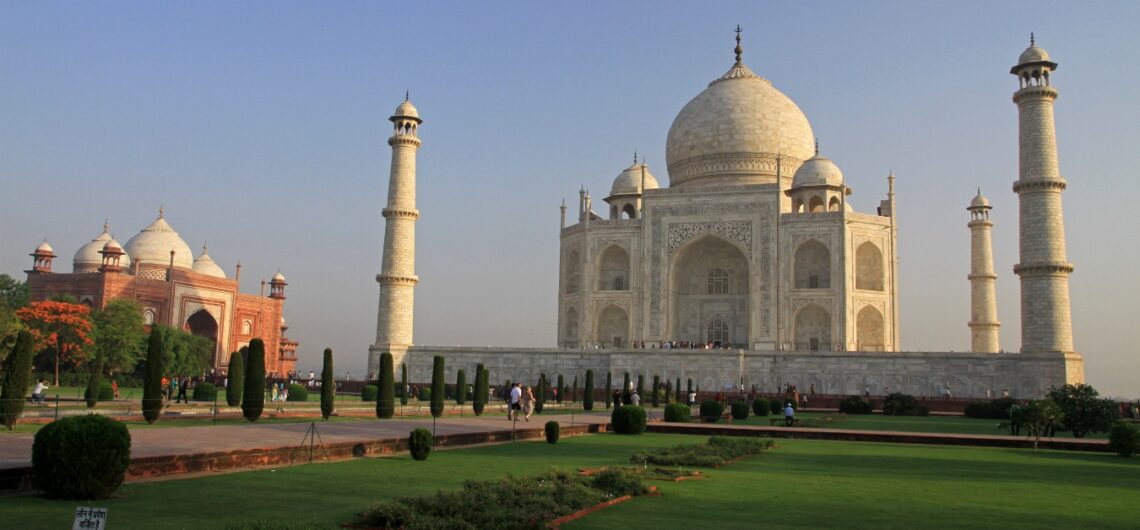Overview of Hidden Symbolism
The Taj Mahal Hidden Symbolism is often regarded as the most beautiful symbol of love. Standing on the southern banks of the Yamuna River in Agra, India, this white marble mausoleum is not only a testament to architectural brilliance but also a profound embodiment of emotional depth, spirituality, and cultural heritage. While millions are drawn to the Hidden Symbolism each year to admire its physical beauty, fewer are aware of the hidden symbolism embedded within its design. Every element of the Hidden Symbolism has a meaning, from the choice of materials to the layout of the gardens, offering insights into the worldview of its creator, Mughal Emperor Shah Jahan, and the era in which it was constructed.

Many people believe that the Taj Mahal is the most exquisite representation of love. This white marble mausoleum, which is located in Agra, India, on the southern banks of the Yamuna River, is a remarkable representation of emotional depth, spirituality, and cultural legacy in addition to being a work of architectural genius. Every year, millions of people visit the Hidden Symbolism to take in its breathtaking physical beauty, but fewer are aware of the subtle meaning woven throughout its architecture. From the materials used to design the gardens, every aspect of the Taj Mahal Hidden Symbolism has significance that sheds light on the worldview of the Mughal Emperor Shah Jahan and the time period in which it was built.
We will explore how the Taj Mahal’s Hidden Symbolism architectural features, design decisions, and decorative elements communicate a deeper narrative about life, death, and eternal love as we peel back the layers of symbolism within this article.
1. The Taj Mahal as an Infinite Love Symbol
The Taj Mahal’s most well-known symbolism is that it stands for unending love. Constructed by Shah Jahan to honor his cherished spouse, Mumtaz Mahal, the mausoleum has endured as a symbol of unwavering loyalty. Mumtaz Mahal passed away in 1631 while giving birth, and the emperor was very saddened by her passing. To commemorate their love forever, he thus ordered the Taj Mahal to be built.
The Taj Mahal’s symmetrical design is a physical manifestation of love, reflecting the idea of harmony and balance in a relationship. This symbolism is enhanced by the mausoleum’s reflection in the central body of water, which illustrates how the couple’s love was balanced and reflective of one another.
White marble was chosen with symbolic meaning in mind. Since white is typically linked to purity, the Taj Mahal symbolizes the purity of Shah Jahan’s love for Mumtaz Mahal.
That being said, this is merely the most obvious layer of meaning Hidden Symbolism. Beyond this romantic story, the Taj Mahal’s true significance is far more profound.
2. Divine Order and the Geometry of Perfection
The Taj Mahal’s geometric accuracy is among its most remarkable features. The Mughal concept of symmetry and harmony as reflections of the divine order is embodied in the complex’s layout, which is based entirely on rigorous mathematical principles. Islamic architecture always uses geometry to illustrate the ultimate unity of God and the perfection of the cosmos, not just for aesthetic purposes.
The Symmetry of Symbolism: The equilibrium between heaven and earth, life and death, is symbolized by the Taj Mahal’s flawless symmetry. From the two mosques that are located on either side of the central mausoleum to the four minarets that flank the tomb, every architectural element of the Taj Mahal is mirrored in the other. This symmetry alludes to the idea that everything in life is interconnected and has a divine balance.
The Mughals’ belief in the unity of God is further emphasized by symmetry. Symmetry is viewed in Islamic tradition as a reflection of the divine creation, in which everything is perfectly placed.
How to Apply the Golden Ratio:
The Golden Ratio, a mathematical ratio frequently connected to harmony and beauty in nature, is used in the architecture of the Taj Mahal. This supports the theory that the Taj Mahal symbolizes ideal beauty that reflects the divine order of the universe, rather than merely physical beauty.
3. The Meaning of Shadow and Light Symbols
It’s well known that the Taj Mahal’s appearance changes throughout the day. It glows pink in the morning, turns golden at sunset, and becomes softly glowing at night under the full moon. Not only is the way light and shadow interact visually pleasing, but it also serves as a metaphor for life’s fleeting nature.
The Taj Mahal’s shifting hues give the impression that life is fleeting, serving as a constant reminder to onlookers of time’s passing and death’s inevitable outcome. The monument’s ephemeral beauty at various times of the day is a metaphor for life’s transient nature.
The dynamic interplay between light and shadow also represents the duality that permeates all aspects of existence, including joy and sorrow, day and night, and life and death.
The use of light in the Taj Mahal has a spiritual component as well. Light is a ubiquitous symbol of the divine in many religious traditions. The Taj Mahal’s ability to capture and reflect light is a symbol of both the idea that divine light guides the soul after death and the existence of the divine in all facets of existence.
4. The Gardens as a Paradise Metaphor
The Taj Mahal’s gardens are an essential component of its meaning. The Islamic idea of paradise, which is frequently depicted in the Quran as a lovely garden with flowing water, abundant vegetation, and fruit trees in abundance, is usually the source of inspiration for Mughal gardens. This vision of paradise is reflected in the design of the gardens at the Taj Mahal.
The garden of the Taj Mahal is designed in the traditional Persian style known as Charbagh, which is divided into four sections. The four quadrants stand in for the four rivers of paradise—water, milk, honey, and wine—that are mentioned in Islamic writings.
The pathway to eternal life is symbolized by the central water channel that flows through the garden and mirrors the river that flows through paradise. By dividing the garden into symmetrical sections, it emphasizes the divine order and balance symbolism.
Relationship Between Heaven and Earth: The garden is thought of as a transitional area between the heavenly paradise and the world below. The concept is that a stroll through the garden serves as a reminder of the eternal paradise that is the ultimate destination of the soul.
The garden serves as a metaphorical depiction of the journey from life to death and then to eternal paradise. Mumtaz Mahal’s tomb is located at the northern end of the garden, signifying her ascent to the afterlife.
5. Calligraphy: An Intense Communication from Heaven
The extensive use of calligraphy in the Taj Mahal’s design is another significant feature. Arabic calligraphy known as Thuluth script is used to write text that covers the monument’s arches and walls. Most of the text is taken from the Quran. The purpose of selecting these verses was to accentuate the building’s spiritual symbolism.
The Symbols of Mortality in the Quran:
Numerous passages about judgment, paradise, and God’s mercy are inscribed on the Taj Mahal. These inscriptions function as a gentle reminder of the afterlife and the notion that the soul is eternal.
For instance, “O Soul, thou art at rest” is one of the Great Gate’s most noticeable inscriptions. Come back to the Lord in harmony with Him and with yourself.
This passage highlights the Taj Mahal’s significance as a mausoleum and a representation of everlasting peace by reflecting the Islamic belief in the peaceful return of the soul to God after death.
The Visual Art Form of Calligraphy:
Additionally, calligraphy has a decorative purpose. The Arabic script’s tasteful curves and deliberate spacing enhance the monument’s overall aesthetic appeal by fusing artistic form with spiritual meanings.
The text appears uniform from the ground because of a clever optical illusion in which the letters get bigger as they go up the walls. The idea that the Taj Mahal is a work of art inspired by divine beings is strengthened by this attention to detail.
6. The Dome: A Heavenly Symbol
One of the Taj Mahal’s most recognizable features is its central dome. Visible for miles around, the lotus-shaped dome rises elegantly above the mausoleum. In Islamic architecture, domes frequently represent the vault of heaven; in the case of the Taj Mahal Hidden Symbolism, the dome symbolizes the afterlife spiritual union of Mumtaz Mahal and Shah Jahan.
The Lotus Dome: In both Islamic and Hindu cultures, the lotus blossom is a representation of divinity and purity. The Taj Mahal’s architects integrated these symbolic connotations into their design by selecting the lotus-shaped dome, resulting in a structure that pays homage to both religious traditions.
The idea that the Taj Mahal Hidden Symbolism is more than just a tomb but also a portal to paradise is strengthened by the dome’s upward thrust, which represents ascent to heaven.
The Design of the Double Dome:
The dome of the Taj Mahal is actually a double dome, a design choice that preserves the building’s more intimate scale inside while enabling an incredibly striking exterior. The idea of hidden truths and the dual nature of existence—the outside world and the inner spiritual world—are symbolized by this hidden complexity.
Another Islamic symbol is the crescent moon finial at the top of the dome, which stands for the moon, stars, and the soul’s celestial journey.
7. The Minarets: An Icon of Faith and Safety
In addition to being ornamental, the four minarets that encircle the Taj Mahal have symbolic meaning. While minarets are typically used as towers from which the call to prayer is delivered in Islamic architecture, they have a more symbolic function in the Taj Mahal Hidden Symbolism.
Guardians of the Tomb: The minarets serve as the mausoleum’s sentinels, keeping it safe from external threats. This shielding symbolism supports the notion that Mumtaz Mahal’s soul needed a haven, and Shah Jahan intended to build it.
In addition to being a smart engineering move to safeguard the main structure in the event of an earthquake, the minarets’ slight outward tilt has symbolic significance. The minarets appear to be bowing in humility before God, as indicated by their outward tilt, to the central tomb.
Faith Symbol: The four minarets stand for the four pillars of Islam, which are fasting, prayer, charity, and faith. Their incorporation into the Taj Mahal’s design represents the spiritual basis upon which the monument is erected and connects the building’s physical design to Islamic conceptions of life, death, and the afterlife.
In summary
The Taj Mahal Hidden Symbolism is much more than just a stunning structure Hidden Symbolism. Every aspect of its architecture, including the gardens, the dome, the calligraphy, and the symmetrical arrangement, has profound symbolic significance. These components work together to tell a tale of paradise, love, death, and the universe’s divine order. The Taj Mahal Hidden Symbolism is evidence of the Mughal philosophy, which saw life and death as interwoven with a larger cosmic balance, as well as of Shah Jahan’s love for Mumtaz Mahal. The Taj Mahal never fails to enthrall and inspire visitors with its architecture, artistry, and symbolism—giving them a peek of the timeless truths that are concealed within its walls.


Comments